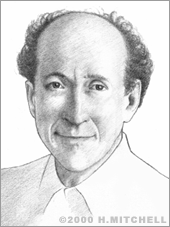Robert Dennard
In 1967, Robert Heath Dennard invented what is considered one of the most significant advances in computer technology: one-transistor dynamic random access memory, or "DRAM."
Born on Sept. 5, 1932 in Terrell, Texas, Dennard attended Southern Methodist University in Dallas, receiving his BS in 1954 and MS in 1956 in electrical engineering. Just two years later, he was awarded a PhD, also in electrical engineering, from Carnegie Technical Institute (now Carnegie Mellon) in Pittsburgh.
Upon graduation, Dennard joined IBM’s research division as Staff Engineer. He began his career in an era when technicians fed punchcards into computers so big that they filled rooms and required their own air conditioning systems. The first commercially available computer, UNIVAC, had been produced in 1951, but the notion of an average person owning a computer was still somewhat of a dream.
In 1959, Jack Kilby's invention of the integrated circuit constituted the first step toward the feasible personal computer because the microchip made it possible to drastically reduce the size of a computer's main memory storage unit. In 1966, Dennard took the second step. That year, his research team was working on field-effect transistors (FETs) and integrated circuits, using the then standard six-transistor memory cell for each bit of data. After an in-house presentation by a rival IBM team piqued his sense of competition, Dennard set out to streamline the memory cells that he was working on.
At that time, RAM was a known and used concept: memory reserved for writing to and reading from in a temporary fashion, to be erased every time the computer is turned off. However, in the mid-1960s RAM required an elaborate system of wires and magnets that was bulky and power hungry, negating in practice RAM's theoretical efficiency. Magnetic memory was, in effect, quite expensive as well.
Dennard's revolutionary achievement was to reduce RAM to a memory cell with only a single transistor. His key insight was that it should be possible to store binary data as a positive or negative charge on a capacitor. After several months of experimenting, Dennard had reduced his RAM cell to a small capacitor and a single field-effect transistor, gating the flow of data to and from a data line. The ultimate effect of Dennard's invention was that a single chip can hold a billion or more RAM cells in today’s computers.
Dennard was granted a patent for his one-transistor DRAM in 1968. By the early 1970s, the first DRAM chips became commercially available, and by the mid-1970s, DRAM was standard in virtually all computers. When personal computers became a realistic possibility, Dennard's system allowed them to perform complex operations and still fit on a desktop and later, to become affordable. The rise to prominence of the PC made Dennard a natural choice for the National Medal of Technology in 1988.
Since then, "How many megabytes of RAM. . .?" has become a commonplace question, and the answers are more impressive for each new generation of computers. Dennard’s discovery led to the development of the portable computing age, making possible the creation of hundreds of gadgets, from laptops and cell phones to portable music players, gaming devices, and digital cameras.
A Fellow of IBM's T.J. Watson Research Center since 1979, Dennard has continued his career of invention with refinements to RAM, specialized FETs, and low-voltage, high-performance operation of circuits. He is also a co-author of "scaling theory," an analytical framework for studying the special conditions of engineering microchips in ever more microscopic dimensions. He published this theory in the 1974 paper “Design of Ion-Implanted Metal-Oxide Field Effect Transistors (MOSFETs) With Very Small Physical Dimensions.” This is now a “classic paper” as recognized by the Proceedings of the Institute of Electrical and Electronic Engineers in 1999.
Over the course of his career, Dennard’s work has resulted in 35 patents, some 90 published papers, and numerous awards, including induction into the National Inventors Hall of Fame in 1997 and the Edison Medal from the IEEE in 2001. In 2005, he was awarded the $100,000 Lemelson-MIT Lifetime Achievement Award.


